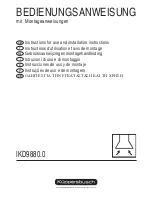
EXTRACTOR HOOD INSTALLATION INSTRUCTIONS
1.
Examination
Before starting the actual installation, the device should be checked. In addition to checking externally
if there is any visible damage, a function check must also be carried out. For this purpose, the device has
to be removed from the packaging and from all packaging materials and placed on the back of the
floor/table. After connecting to a power supply, the lighting can now be used, as well as the function of
the individual stages can also be checked.
2.
Preparation
The hood must be installed in a cabinet. It is advised to remove the cabinet from the wall for assembly in
order to ensure easier access. A rectangular opening 540 x 290 mm must be marked and cut in the bottom
of the cabinet (Fig. 4). The opening is to be placed in the floor in such a way that the lower part of the flat
screen hood does not protrude over the side walls after installation and the front panel closes at the same
height as the cabinet door. It is fastened to an intermediate floor that is installed at the appropriate height.
The height of the intermediate shelf is 220 mm from the lower edge of the cabinet to the lower edge of
the intermediate shelf. The exhaust air opening with a diameter of 150 mm must be cut at the appropriate
point in the false floor. It is advised to make this opening a little larger in order to compensate for
measurement inaccuracies. The hood is attached to 4 holding holes that are equipped with threads. These
are to be measured and holes are to be drilled in the same place in the false floor. The air discharged from
the hood must be expelled outside the cabinet, regardless of whether it is used in recirculation or exhaust
mode. In this respect, it is necessary to introduce an exhaust air opening in the cabinet ceiling in the same
place as on the intermediate floor. Through this, either the exhaust air hose is routed to the wall outlet or,
in recirculation mode, a pipe or hose connection is created that directs the air out of the cabinet.






































